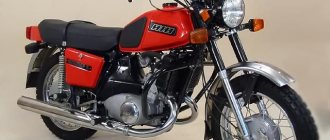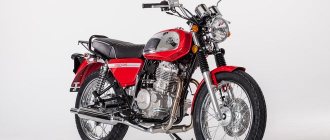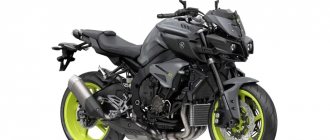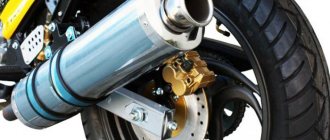Piston ringing, what is it really, detonation or pin, bushing, piston?
We are talking about IZH Planet 5. The fact is that for many, as in my case, when replacing a piston with a new one, a ringing metallic sound appears at the top of the head, whether it goes away or not... I had 3 piston ones and I filled everything with 92 liter gasoline, it was everywhere metallic ringing at the top of the head...
But how can this be logical?, when: - the piston is tight in the sleeve - the pin is driven hot into the piston - the pin sits tightly in the bushing - the kv has no play, like the connecting rod
We need to find out the reason for this phenomenon and get down to business!
As it turned out, when measuring the stock and fan combustion chambers, the following was revealed: Stock head = 56-57ml Fan head = 46-47ml
From this comes the following compression ratio according to the formula 340cc divided by the combustion chamber +1 = approximately: Stock head = 7.2 Fan head = 8.2 - 8.5
The gasket under the cylinder head is 1 mm, that is, an increase in the combustion chamber, in turn, a decrease in the compression ratio. 1 mm of height displaces 4-5 ml of liquid; displacement of the piston sphere 3 ml (3.5) of liquid when summing up is rounded to about 7-8 ml
I have a cylinder without a gasket and the combustion chamber is 40 ml, a total of 9.5 compression ratio, when using 92 gasoline, the ringing increases with increasing speed.
And so in my case we have a piston diameter of 72, a piston stroke of 85 = 340cc \ 40ml +1 = using these data you can calculate how much you need to trim the head or put a gasket to adjust the compression ratio to the desired gasoline: - head with gasket = 8.2 - head without gasket = 9.5 (provided that the piston protrudes from the cylinder by 1mm in height) - a head that is cut to 1mm = 4-5 ml of liquid, displacement by the piston is 3-4 ml, that is = 7-8 ml, everyone can calculate further calculations for themselves.
If you believe data from the Internet, then the ratio of the compression ratio to the octane number of gasoline: 92 - up to 10.5 95 - 10-12.5 98 - 12-14.5
Why did I do all this?, but to fight DETONATION !!! After all, the ringing at the top of the head is always confused with the ringing of a finger, piston, skirt and everything else.
Solutions: - reconfigure the ignition, the higher the octane number, the longer the mixture burns, which means, for example, for 92 you need 1.5mm before TDC, 95 - 2.5mm before TDC. You can select experimentally from 1 to 3 mm. - enrich the mixture, a lean mixture leads to detonation. — try to fill in gasoline with a different octane number. — try with head gaskets and trimming the head until detonation is eliminated.
Ignoring such a ringing can lead, as in my case, to the melting of the piston; nevertheless, pistons are no longer made from the best alloys.
Izh history of motorcycles from the Izhmash plant
The history of motorcycles began thanks to the legendary engineer and avid motorcyclist Pyotr Vladimirovich Mozharov, who for the first time in the Soviet Union became the organizer of motorcycle production. Back in 1928, Pyotr Vladimirovich submitted an official proposal to organize the production of high-quality and fast motorcycles at Izhstalzavod. The engineer achieved his goal and after some time at Izhstalzavod in Izhevsk, a separate design bureau was created, which was engaged in the production, design of motorcycles and their first testing.
Photo of the IZH-1 motorcycle
In 1932, a commission was created, by whose decision the first samples of the IZH-1 and IZH-2 motorcycles were prepared; it was then that the decision to organize the Izhevsk Machine-Building Plant was first made. Production proceeded by leaps and bounds, it seemed that the history of IZH motorcycles did not end and would never end! Already in 1933, production of IZH-7 began. This motorcycle model was modified, improved, with new functionality; it was a variant of the German L-300. By the way, IZH-7 can still be found today; thanks to high-quality assembly, such “machines” can operate for decades.
Photo of the IZH-7 motorcycle
During the Great Patriotic War, the production of Izhevsk motorcycles was sluggish. Unfortunately, mass production of IZH motorcycles for non-military purposes continued only in 1946. In 1945, after the end of the war, another design group was assembled and set to work creating new IZH motorcycles, but everything turned out to be much simpler than everyone thought. After some time, drawings and technical documentation for the DKV “NTs-350” motorcycle were brought from Germany and the designers made a decision: not to change anything, to start producing the new IZH-350 motorcycle. Of course, soon there was a modernization, which revealed numerous errors of the German motorcycle and a completely new vehicle, of native domestic production, began to be called IZH-49 and went out of production in a short time.
Photo of the IZH-49 motorcycle
By the end of the 70s of the last century, Izhevsk became a motorcycle city that produced more than 350 thousand motorcycles per year! In the 80s, sports motorcycles began to be produced, which were intended primarily for road racing and various cross-country competitions. Motorcycles from Izhevsk gained particular popularity when the plant began to produce models such as “Izh-Jupiter”, “Izh-Planeta”, “Izh-Yunker”, “Izh-Planet Sport”.
Photo of the IZH Jupiter-5 motorcycle
In conclusion, I would like to note that today the domestic motorcycle market is rather weak competition for many global manufacturers. This applies not only to design solutions, but also to technical equipment. However, despite their irrelevance, and thanks to low prices, simplicity of design, control and quality, Izhevsk motorcycles are still relevant among the people.
I invite you to watch a video about the IZH motorcycle museum
Soviet motorcycles for ShKMG, part 23: IZH - Sh 11.
In 1969, the Izhevsk Motorcycle Plant began production of the Sh 11 model. This motorcycle left a noticeable mark on domestic motorsports and served as the basis for subsequent models - Sh 12 and 6.217.
The need for such a motorcycle was long overdue - athletes needed a motorcycle that would be produced, if not in large quantities, but at least in small series. By the early seventies, the Serpukhov plant had moved away from motorsports, and other manufacturers showed no interest in the production of racing motorcycles. This situation forced athletes to perform on outdated equipment or even use homemade designs. For example, an article in the magazine “Behind the Wheel” talks about one of these motorcycles. Its creators, the great Jüri Randla and Endel Kiisa, need no introduction.
Sh 11 was an almost completely original design; with serial IZHs it was only related to the engine crankcase, crankshafts, and some gearbox parts, as well as small parts, such as levers on the steering wheel, chains and cables. The frame, wheels, brakes, and the entire body kit were made specifically for Sh 11 and were original. The lower cups of the front fork were shortened by 40 mm, and its stroke was reduced. The rear shock absorbers have also been modified for racing use. The cylinders and heads, although they had a design similar to the parts of Jupiter 2, were very different. The number of gear ratios in the gearbox has been changed. The ignition remained cam, but was powered by a battery; the generator was excluded from the design.
Illustration from the magazine “Behind the Wheel” for July 1970.
The engine power, thanks to the use of different valve timing, heads with a higher compression ratio, other pistons and resonators, was 35 hp. , while Jupiter 2 had 26, but plant representatives claimed that it could be raised to 45 or even 50 hp. On later IZH-Sh 11, the basis for the engine was Jupiter 3.
The photographs show a pre-production prototype of the IZH-Sh 11.
19-inch wheels, brake drums with a diameter of 200 mm. Double-cam brakes, reinforced brake cables.
The exhaust system consisted only of resonators; the factory did not provide mufflers. However, the riders, of course, made changes within the rules.
IZH Sh 11 gave the opportunity to engage in motorsports to a wider range of people. The country's best riders, such as Lembit Teesalu, competed on Sh 11.
Lembit Teesalu on IZh - Sh 11. The motorcycle was modified by the production association for the production of sports equipment "Vihur" of the Central Committee of DOSAAF USSR in Tallinn, from what can be seen in the photo - it has a different fairing, tank and tail.
IZH - Sh 11.
IVARS BLUMFELDS racer, 1978.
The IZH-Sh 11 was produced until 1974, after which its production was discontinued and it was replaced by the IZH-Sh 12. Now the IZH-Sh 11 is a very rare motorcycle, but it can be seen in museums and private collections in Russia and abroad.
IZH - Ш 11, sold on E Bay in 2013, further fate is unknown.
IZh - Ш 11 from Mootorispordi Muuseum, Estonia.
Another IZH is Sh 11 from Estonia.
IZH-Sh 11 1972 produced by our friend from Latvia Edgars.
IZH - Ш 11 from the collection of the museum of the UMMC plant in Verneya Pyshma.
Read about the further development of Izhevsk racing motorcycles, model IZH - Sh 12, in the following publications.











